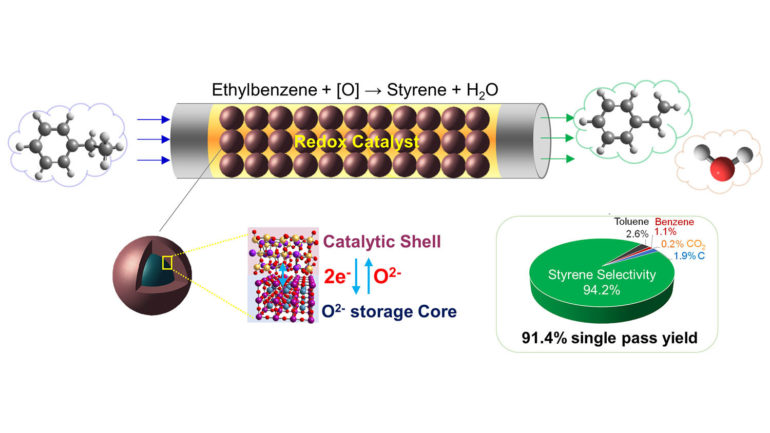Chemical engineering researchers have developed a new catalyst that significantly increases yield in styrene manufacturing, while simultaneously reducing energy use and greenhouse gas emissions.
“Styrene is a synthetic chemical that is used to make a variety of plastics, resins and other materials,” says Fanxing Li, corresponding author of the work and Alcoa Professor of Chemical Engineering at North Carolina State University. “Because it is in such widespread use, we are pleased that we could develop a technology that is cost effective and will reduce the environmental impact of styrene manufacturing.” Industry estimates predict that manufacturers will be producing more than 33 million tons of styrene each year by 2023.
Conventional styrene production technologies have a single-pass yield of about 54%. In other words, for every 100 units of feedstock you put into the process, you would get 54 units of styrene out of each pass. Using their new catalyst, the researchers were able to achieve a single-pass yield of 91%.
The conversion process takes place at 500-600 degrees Celsius—the same temperature range as conventional styrene manufacturing processes. However, there is a big difference.
“Current techniques require injecting very large volumes of steam into the reactor where the conversion takes place,” says Yunfei Gao, a postdoctoral scholar at NC State and co-lead author of a paper on the work. “Our technique requires no steam. In practical terms, this drastically reduces the amount of energy needed to perform the conversion.”
Specifically, the conversion process that incorporates the new catalyst uses 82% less energy—and reduces carbon dioxide emissions by 79%.
“These advances are made possible by the engineered design of the catalyst itself,” says Xing Zhu, co-lead author of the paper and a researcher at the Kunming University of Science and Technology (KUST). “The new redox catalyst has a potassium ferrite surface for the catalytic phase and a mixed calcium manganese oxide core for lattice oxygen storage.” Zhu worked on the project as a visiting scholar at NC State.
“In order to adopt the new catalyst, styrene manufacturers would need to adopt a different style of reactor than they are currently using,” Li says. “They would need something similar to a CATOFIN reactor. But those are already in widespread use for other industrial applications. And the cost savings from the new process should be significant.”
The paper, “A tailored multi-functional catalyst for ultra-efficient styrene production under a cyclic redox scheme,” is published in the journal Nature Communications.
Catalyst opens door to more efficient, environmentally friendly ethylene production
More information:
Xing Zhu et al. A tailored multi-functional catalyst for ultra-efficient styrene production under a cyclic redox scheme, Nature Communications (2021). DOI: 10.1038/s41467-021-21374-2
Provided by
North Carolina State University
Citation:
New catalyst makes styrene manufacturing cheaper, greener (2021, February 26)
retrieved 28 February 2021
from https://phys.org/news/2021-02-catalyst-styrene-cheaper-greener.html
This document is subject to copyright. Apart from any fair dealing for the purpose of private study or research, no
part may be reproduced without the written permission. The content is provided for information purposes only.



